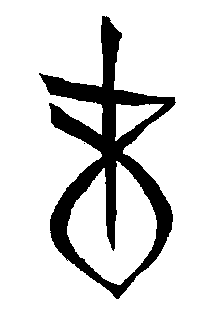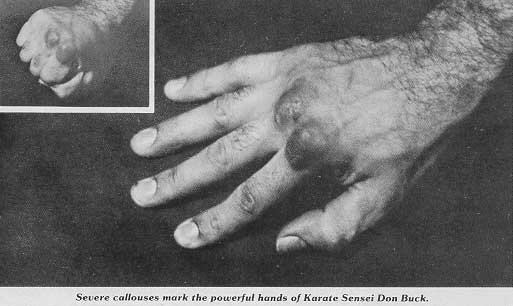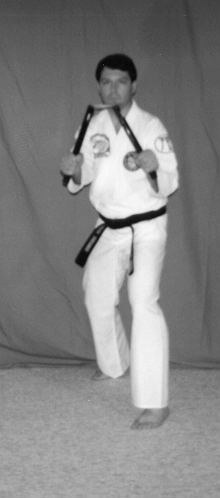


Weapons of Karate by Steve Denoo




CNY Karate,Syracuse, NY
Kyokushin,Japan
Kyokushin,Endicott,NY
Kyokushin world news
|
newsletter
|
We must train our body and spirit. In order to have a strong punch you must develop not only strength in the fist, wrist, shoulders, and back you must develop strong internal energy. Internal energy is also the primary factor in maintaining good health; it keeps the internal organs in good condition for good mental and emotional health; strong internal energy bestows a radiant, substantial sense of well-being and good humor. The following is a chi building exercise.
One of my favorite Ki (Chi, use either one) stories goes like this: A sword-master wished to test his top three students. He took them to a narrow ravine in which a fierce wild horse lived, and told them to come through one at a time while he positioned himself at the other end of the ravine. The first student started through, and when the wild horse lunged at him he skilfully blocked and dodged the horses hooves, and went through to where the master was waiting. Feeling proud of himself, he turned to see his fellow students and how they would make out. The next student, seeing th horse from a distance, nimbly climbed up the walls of the ravine, passing far above the horse's head and out of range. The horse tried to reach him but could not. So he also joined his master on the other side. The third student appeared at the mouth of the ravine; calm and unconcerned, he walked through the ravine, the horse winnid and greeted him and ignored him. The third student used what his master had taught him, he projected himself as no threat, and the horse ignored him. Just as Ninja would do, no one seemed to notice them. This is a technique that can be developed, it is not impossible. You must learn to relax, meditate, control your thoughts. In future writings I will go into some of these techniques further. Osu ! 1.The Hands - Fore-fist, When they take away our weapons, we make every hand, foot, or finger a sword, club, or spear.
When they take away our weapons, we make every hand, foot, or finger a sword, club, or spear.There are 50 or so weapons in Martial arts, Karate is an empty handed art therefore only uses a few of them. You must learn from a qualified instructor. Weapons training is to be used as an extension of the body. 2. Knife Hand
3. Foot
4.The Nunchuck The Nunchaku is the weapon immortalized by Bruce Lee in many of his movies. It is a member of the flail family. It is made by attaching two sticks of approximately 12 inches in length, together with a rope or chain. Of course, in Okinawa in the 1600s chain was not used to join the shafts. Rope was the primary method. The proper length of the Nunchaku should normally equal the distance from the middle of your hand to your elbow. Having the proper length Nunchaku will allow the karateka to hold the nunchaku together at the top of the shaft, using each shaft as a protection or guard for the forearm. The shaft of each stick can be either round or octagonal. Different woods will give the nunchaku different weights. The shaft of the nunchaku has three areas, mainly defined by where you would grip or catch the nunchaku: the upper area, the area closest to the rope or chain; the middle area; and the lower area. 5. The Bo The Bo staff is nothing more than long stick. Traditionally it measured six feet in length, but both shorter and longer versions were used depending on the situation and practitioner. It normally has a diameter of 1 � inches at the center, tapering out to a diameter of � inch at the ends. This tapering is done to concentrate and centralize the force focused in striking the opponent. However, the Bo could have a constant diameter throughout it�s length. The Bo usually is made of hard wood that would not easily split, however bamboo or rattan can be used when flexibility and weight is an issue. History The Bo staff is probably one of mankind's oldest weapons. They belong to the same family as spears. The bo was commonly used to carry buckets of grain or water, one on each end of the staff for balance purposes. When attacked, the defender could easily slip the buckets off each end and have a very handy weapon. Or staffs would be used as a walking implement. When attacked, what seemed a harmless tool, became a deadly weapon.
6. The Kama The Kamas are better known as sickles. They consist of wooden shafts with a metal blade set at the top. The inside edge of the blade is sharp while the outside edge is blunt. Kamas are used in pairs. Some practitioners have a rope or leather cord strung through the base of the handle. This cord wraps around the wrist, allowing the Kamas to be twirled in motions similar to Nunchaku. Because of the deadliness of the sharp blades, practice kamas for the beginning Karate-ka are usually made all of wood, including the blade.Usage The kama tends to be employed close to your opponent. Kamas use much more sweeping motions then other weapons. These motions include: hooking, hacking, and chopping. Not all of these slashing motions have direct counterparts in karate. The blades add an extra deadly feature to this weapon. The practitioner may block a technique with the wooden shaft, only to shift the Kama, pulling the sharp blade across the opponent's arm or leg. What's more, one Kama could be executing a block, while the second kama is slashing at the opponent. Finally, both kamas could be swung simultaneously, creating a sort of propeller effect.
7. The Sai The Sai consists of a metal shaft with a wrapped handle. The normal length of a sai is 18 to 21� inches in overall length. They look like a miniature trident. To properly size the sai , the blade should extend one inch past your elbow so that the sai can fully protected your forearm. One third of the way from the bottom of the shaft, two prongs protrude upward, acting as a hand guard. The shaft tapers slightly toward the tip. At the bottom of the handle is a butt end that can used for striking techniques similar to a karate punch. Current Sai are normally chrome plated with the blade (part above handle guard) normally in either an octagon shape or round. The round blades resists chipping better than the octagon one. However, the octagon blade does more damage on impact because the striking area is more concentrated. Sai usually come in pairs. However, some practitioners were believed to carry three, with the third one being using as a throwing implement. The goal was to knock a rider off their horse, not by stabbing them, more by the sheer weight of the Sai. Or, the practitioner had a third one if they dropped or lost one sai. |